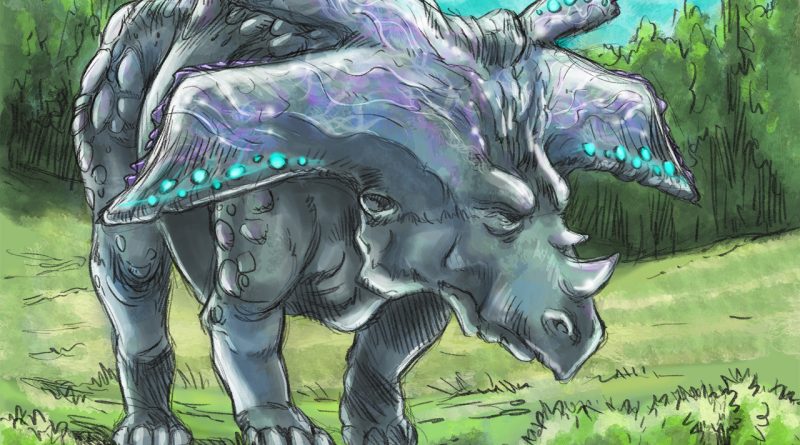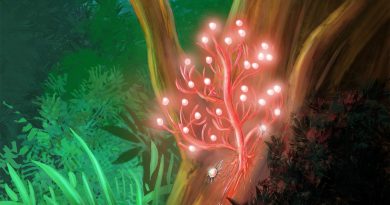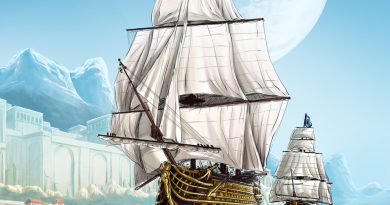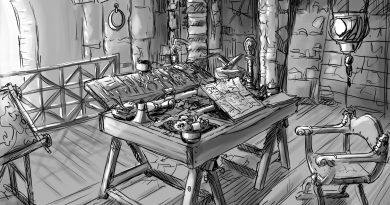3-The Mammalians
There are terrifying creatures, yes there are. I’ve seen so many, more frightening and deadly than the mind can manage to imagine. I’ve seen the savage, cunning rage beyond comparison of the great Draekya. I’ve glimpsed the devastation of terror and death sown in one night by a Morrow. Or those guardian-machines of the Ancient ruins that nothing can stop or curb, who exist only to exterminate all those who would dare disturb their long-dead masters. Even the most beautiful flowers, like the synthaia, are nothing but death traps adorned with deception. Not one of these city-dwellers who boast of their strength and civilization could survive more than a day in the most modest of forests. But make no mistake, Anis, even if you already know: the worst of the monsters, the greediest, the most dangerous, the cruelest, the most devious and the most determined to destroy what only wants peace, are men.
Eïm the Traveller.
The Mammalians
The taxon that dominates the Loss ecosystem is the mammalians. Creatures of all sizes, but prone to gigantism, they possess teats and suckle their young, but also lay eggs. They are oviparous vertebrates (with the exception of a few viviparous families, notable for their small size, such as lorises). They are characterized by suckling young, a developed and evolved nervous system, a brain divided into several separate bulbs, a double heart with four eccentric chambers, homeothermy (stable control of their internal temperature), air sacs (respiratory organs connected to the lungs) and the presence of external bony plates or ridges along their spine and around their skull.
Insert: a taxon (from the word taxonomy) is a conceptual entity that is supposed to group together all living organisms that share certain well-defined taxonomic or diagnostic characteristics. The mammalian taxon groups together five major orders, a recent classification but one familiar to lossyan naturalists.
- Sikaidae, mammalians related to quadrupeds such as sika and mora, with forms similar to our herbivorous quadrupedal mammals, not forgetting all rodents and smaller mammals with a generally vegetarian diet.
- The draseidae, six-legged mammalians, including the dragen, often capable of flight.
- Arafidae, giant mammalians similar to our dinosaurs, from the ghia-thunder to the largest species of longilas and the forest walker.
- Venidae, quadrupedal predators with features in common with mammals, from the lori to the draekya and the tosh.
- Raptidae, bipedal predators related to the various griffon families.
Mammalians come in many shapes and metabolic variations. Some, for example, have six limbs, several species have fur or down, others are perfectly adapted to the aquatic environment, and there are as many bipeds as quadrupeds. A striking feature is their average size: that of a bear (compare with the average size of a mammal: that of a dog). Yes, mammalians are big and tall, just like the flora of Loss, which isn’t faking it either. The smallest weigh between 3 and 6 kilos, while the largest exceed 40 tonnes and can measure 8 metres at the withers. The race for gigantism has clearly been one of the evolutionary choices of this taxon, apparently barely held back by massive cataclysms, the latest of which was the Long Winter, which eliminated only a few giant species locally. However, a few archaeologists – the profession doesn’t exist as such on Loss – occasionally find the fossil remains of even more gigantic animals.
Appearance
Mammalians are generally hairless, except in the case of a few species living on the Arctic fringes or other forests, covered with a thin fleece, sometimes consisting of feathery down. Mammalian skin is colorful and variegated, forming patterns for camouflage purposes, which change to flamboyant hues during rutting and breeding periods. Bioluminescent spots and patterns are common. All mammalians have bony plates, horns and ridges, from skull to tail. These plates are very different from one species to another: sometimes they are few and limited to complex horns, other times they form real carapaces and natural weapons, but their presence is one of the constant signs of mammalians.
There are few six-legged mammalians. In these cases, they usually have two pairs of legs and one pair of wings. Flying mammalians aren’t really very agile; they’re more like gliders that need take-off points, and dragens, for example, live in treetops or on cliffs. Finally, many mammalians have a typical draconian skull, sometimes with a horny beak and a well-developed crest. But others have mouths more akin to certain land mammals.
Mammalians never stop growing throughout their lives. Thus, the oldest representatives of the species are also the fattest. The life expectancy of mammalians is quite extensive, but on average, they live about 20 to 30 years. Some species live well over a century.
SENSES & MAGNETORECEPTION
This is one of the oddities of mammalian senses, which is not developed in all species: they possess the ability to perceive electromagnetic fields (magnetoreception). This enables them, on the one hand, to clearly identify the fluctuating magnetic poles of Loss and use them to orient themselves, and on the other, to sense the proximity of magnetic field variations, including those emitted by other living beings. This sense, coupled with sight, hearing and smell, is formidably effective for spotting hidden prey. In this respect, the draekya is the champion of Loss, even more efficient than its aquatic cousins, and only dragens come close. Fortunately, the widespread griffon has very limited magnetoreception. Mammals’ other senses are highly varied, but nature seems never to have endowed any of them with echolocation capability, except for aquatic mammals. Infrared vision is uncommon, but it does exist and seems to be linked to a symbiont.
SYMBIONTS AND MAMMALS
Like everything else on Loss, mammals are colonized by symbionts. On average, around 30% of mammalians live with a symbiont implanted in their body. The outward difference is not usually visible from a distance, but the largest, oldest females in a mammalian herd are sure to carry a symbiont. Symbionts live with mammalians to their mutual benefit, and some symbionts bring major benefits to their hosts. The effects of symbionts on mammalians are described in detail in the chapter on Symbionts.
Behavior
Given that mammalians are present in all ecosystems, the following information is very generic, and therefore focuses only on the points in common between all mammalians. Of course, behaviors often vary according to species and environment.
HIERARCHY & HERDS
Among mammalians, females are the largest and dominate herds and hordes as the leader or alpha. Pack behavior is common among mammalians, including herbivores, carnivores and opportunists. There are few individualistic or solitary mammalians. But they are systematically the most dangerous, like the Draekyas. Herds are organized and hierarchical, with duels between females for dominance and contention for rank within the horde frequent. Adult males tend to keep their distance from the mass of females and young, and dominant females make sure to fend off any over-enterprising males.
REPRODUCTION AND PARENTAL CARE
Mammalians all have rutting periods once a year, except in a few cases such as toshs, which have three or four, and lorises, which have two. During this period, males parade as much as possible to attract and impress females, and some species fight to demonstrate their virility and scare off suitors. At such times, it’s best not to disturb the males, who are aggressive and excited to the extreme. But it’s the females who choose their males. Couples united for life are extremely rare, and the male takes very little part in parental care, usually being chased away by the female when she’s ready to lay. Mammalians lay from one to ten eggs at a time, which are incubated for an average of one to two months. Some mammalians build a complex, insulated nest – sometimes constructed by the male – to keep the eggs at the right temperature. The mother’s care lasts well after hatching; mammalians look after their young for at least several months, even years after birth. This care differs, however, between migratory and territorial species.
PREDATION AND DEFENSE
Mammalians are equipped with a number of varied, exotic and deadly natural weapons and defenses. They often have solid bone armor adorned with tusks, spikes and other natural weapons, in addition to claws and fangs. But they also have venoms and toxins, through their bite, stings or exuded through their skin. Finally, some have bioelectric weapons powered by organs containing small quantities of loss-metal. In this field, the most fearsome examples of varied and deadly natural weapons are the draekya, which has luminescent flagella capable of launching terrible high-voltage discharges, and the ghia-thunder, which blows a cloud of water sprays electrified by its accumulator organs located in its crest. Size and gigantism are also a defense, including for placid longilas, which are terribly dangerous given their mass when they trample anything that doesn’t get out of their way. Many predatory species have a mimetic epidermis, making them easy to blend into their environment.
MOVEMENT AND FEEDING
While there are flying and aquatic mammalians, there are few mammalian burrowers. Even the tosh doesn’t make real burrows, but invades and builds insect burrows. There are, however, a few good climbers with an arboreal lifestyle. Fliers are a long way from the aerial performance of birds and need space to take off and land; they have difficulty with aerobatics or speed. Aquatic mammalians are capable of performances and adaptations similar to those terran cetaceans. Mammalians are herbivores, carnivores, omnivores and scavengers. They hunt and eat each other from one species to the next, and cases of cannibalism within a species are not uncommon.
Herds of migrating herbivores are frequent, and can number in the hundreds of thousands, always following the same paths, often followed by a variety of predators. Among them, and the most feared on Loss, even more than the dreakyas, which are actually quite rare, are the griffons, which Lossyans have tamed, but which, in wild packs, can stalk and follow their prey for weeks on end. Bipedal omnivores, runners and scavengers, with an adaptation to stalking and prehensile front paws, griffons are the wolves of Loss.
Lossyans and mammals
We’ve already touched on the concern Lossyans may have with their planet’s fauna. Let’s just say that we can imagine the extent of the problem with the simple example that, for certain migratory herbivores, a three-meter-high wall is hardly more embarrassing than a garden fence.
The relative ineffectiveness of trying to exterminate mammalians is well known: sometimes, their behavior has changed in a belligerent and clearly hostile, or even, say some accounts, organized way, in response to an eradication campaign, to the point of seeing normally enemy species, including prey and predator, ally with each other. Many believe this to be a manifestation of the power of shamans, although there is no evidence to support this.
Lossyans have therefore learned to live with large mammalians and keep them away from their farmlands and urban centers, killing them only when necessary. Killing a large mammalian requires considerable resources in any case: a ghia-thunder can barely feel the rifle bullet you’ve just fired into its thorax. Two effective instruments for keeping mammalians at bay are, for example, dogs, for all Lossyan mammalian vermin, and domesticated griffins, which scare off most mammalians, even the biggest and most snarling ones, including the draekya, which only ventures into an urban community driven by its imminent demise, when it can no longer hunt.
Lossyans have domesticated quite a few species: for their meat, leather, fluffy wool and fur, as well as their milk. And of course, some as riding and pack animals and sometimes pets. Here are a few examples:
- Moras: a type of armored warthog bred mainly for meat.
- Loris: the species closest to the cat in terms of ecological niche. They are both pets and tosh hunters.
- Esqiris: large, pudgy marsupial rodents with short fur and partially caparisoned bodies, which reproduce easily. They are raised for their meat and fur.
- Sikas: widespread antelopes in a number of subspecies that form large herds. They are domesticated everywhere, often in semi-liberty.
- Ghia-thunder: a cross between a triceratops and a rhinoceros, ghia-tonnerre are bred in semi-freedom almost exclusively by Ar’hantia nomads. They are sometimes used as pack animals elsewhere.
- Griffons: Griffons are omnivorous, opportunistic scavengers that live in packs. The tame, much more omnivorous version is selected for its (relatively) small size as a mount. They are fairly common, but much less popular than horses, as they are not easy to learn to care for.
- Dragens: winged carnivorous mammalians similar to dragons. The only people who have learned to use them as mounts are the Dragensmanns, who breed them with passion, and the San’eshe, who do the same but much more rarely. Riding and caring for dragens is complicated.




